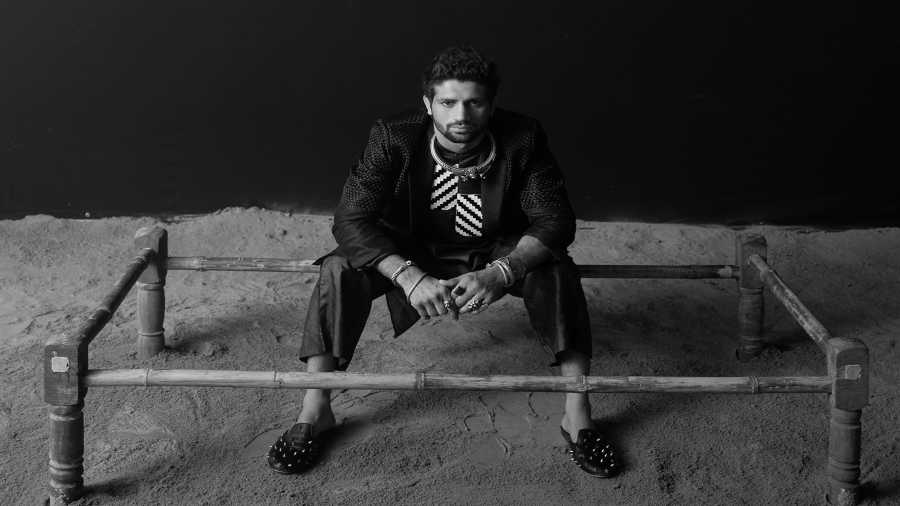Ravi Dahiya loves conquering new frontiers. Whether it's scripting an inspiring comeback to beat Kazakhstan's Nurislam Sanayev in the Tokyo Olympics semifinals or walking the ramp at the Lakme Fashion Week 2021.
The style quotient of India’s latest wrestling star was for everyone to see when he turned showstopper for designer Mohammed Mazhar. But is striking a pose tougher than pinning down wrestling heavyweights in the akhada? “Yes, it’s definitely tough for me, but all you need is practice and preparation and you can do it,” Ravi told The Telegraph.
Ravi was transformed into a wrestling ace at New Delhi’s Chhatrasal Stadium, where Sushil Kumar and Yogeshwar Dutt did the hard yards for years.
But he hasn’t forgotten the priceless lessons from his childhood coach Brahmachari Hansraj. He recalls the things he had learnt at an impressionable age. “The most important thing is to be disciplined, respectful and always keep on pushing. Those qualities I learned at a very young age and they have stayed with me forever,” he said.
Popular as Moni Pehelwan in Sonepat, he hasn’t forgotten his roots despite attaining global recognition, and has immense respect for the mitti of Chhatrasal. “That’s where a real sportsperson’s journey begins. Pehelwani is a way of life. We wake up every day at 3.30 am, even during ice-cold winters, and have at least three to four sessions in mitti. We wet the soil with milk and prepare the soil till it’s ready for practice. Every kushti pehelwan has always started with mitti, if not they at least play mitti dangals in their career,” he said.
Further explaining the benefits of conditioning one’s core in mitti, he added, “A wrestler’s core becomes stronger and the control and movements become sharper on mitti. Your basics become strong, and the transition to mat becomes smoother.”
Unlike others in his ilk, Ravi has no plans to leave Chhatrasal. The only plan he has is to bounce back stronger. Revisiting his Tokyo 2020 final bout against Zavur Uguev, he said, “I had a great experience grappling with him. I know I can defeat him, it’s only a matter of time. I have to work on my in-game time management and the technical aspect of it. Shall come back stronger.”
57kg is a pretty competitive category. There are too many youngsters vying for this zone. “I feel 57 is also one of the toughest weight categories to be in. You need to be extra disciplined and also your weight management needs to be top level. Your diet, training and rest all play a major role. We know if we don’t take care of our diet, weight cutting becomes very difficult, and we have to, at least weeks before the bouts, follow a strict diet and training programme, entirely revolving around the current weight,” he said. He has no plans to shift from this weight category unless “there's a rule change by United World Wrestling”.
The Harayana man pulls no punches while giving advice to those who are still wet behind the ears. So much so that he goes beyond the physical aspect of the game. “My only advice for young guys is to be disciplined and also work on mental fitness along with physical fitness. That will take you a long way,” he said.
Ravi has now trained at Chhatrasal for over a decade. He was taken there by Brahmachari Hansraj back in 2012, and then evolved under the able tutelage of Satpal Singh. So, was there any special treatment after returning to the venue after an Olympic podium finish? “There was no special treatment. There certainly was a celebratory mood when I had returned, and I knew I had inspired many talented youngsters. I aspire to stay grounded and not let the medal get into my head. I have a long career ahead of me and I have to keep doing my best to win more medals for our country. Since the day I returned from Tokyo, I haven't gone home. I went back to Chhatrasal and ensured I stick to my training routine,” he said.
But as the mood turned festive, he did miss Sushil Kumar, whom he had followed and drawn inspiration from all these years. “It was unfortunate what happened with Sushil Pehelwanji. We grew up seeing him train at the stadium and win multiple medals for India. He was an icon for many young wrestlers like me growing up. So it was very unfortunate not seeing him there,” he said.
Ravi plies his trade in the freestyle segment, which is a far more desired category as compared to Greco Roman. All eight Tokyo 2020 qualifications in wrestling belonged to the freestyle zone. “Greco's time will also come as I feel a lot of young wrestlers now have started taking interest in Greco form of wrestling. We need inspiration. It's like how India won the 1983 World Cup and cricket became popular, and when Sushil pehelwan ji won the 2008 Olympic medal, and freestyle wrestling became popular. Lately, a lot of talented wrestlers have done really well in Greco Roman wrestling and this category will only grow,” he explained.
He is 23, has an Olympic silver to his name, and has been recommended for the Dhyan Chand Khel Ratna. "It's definitely a huge honour to be nominated for the Khel Ratna, the highest sporting recognition in the country. This will inspire me to keep working harder and win more medals for my country," he said.
Now what happens next in this inspiring tale makes for another story.











